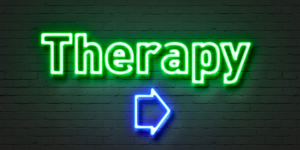Christina Janiga Psychotherapy - Blog
This blog is not a substitute for therapy, but provides evidence-based education for the purposes of self-help and information
What is EMDR Therapy and how does it help with Mental Health Concerns?
Eye Movement Desensitization and Reprocessing, or EMDR for short, is a mental health therapy style that helps to alleviate issues related to: PTSD (post-traumatic stress disorder), trauma anxiety, depression, and a variety of emotional disturbances.
EMDR therapy is a unique method of mental health support that helps the mind recover from emotions in a similar way to the way your body recovers from a physical injury. Just like a wound that is left untreated can get worse, if you do not deal with the initial impact of a traumatic experience, often you may begin to experience mental health challenges stemming from that original disturbing event.
With the right, focused therapy, healing can resume. In EMDR therapy sessions, the therapist guides the clients in using their mind’s innate healing ability through the use of specific movements that encourage a ‘bilateral stimulation’ of the brain. Many studies have confirmed that with the help of EMDR therapy, people can recover far faster from challenging issues, than with traditional psychotherapy alone.
WHAT MENTAL HEALTH CONDITIONS IS EMDR HELPFUL FOR?
- PTSD (post-traumatic stress disorder)
- Childhood trauma
- Sexual assault
- Anxiety & panic attacks
- Phobias
- Depression
- Disordered Eating
- Grief
- Medically resistant pain
- Performance anxiety
- Violence and abuse
- Chronic insomnia
How Trauma Impacts The Brain
 Your brain wants to recover from trauma, but sometimes it can get stuck. It’s amazing how someone may go through a truly horrific event, and yet they have no lingering PTSD, this is often because they were able to get the emotional support and had the ideal physical conditions to process the event completely and are then able to relax and feel safe. However if your fight, flight or freeze response is triggered and nothing is done afterwards to help you to fully come out of the heightened state, your brain can get “stuck” without completing the cycle needed to move this into the normal memory part of your brain.
Your brain wants to recover from trauma, but sometimes it can get stuck. It’s amazing how someone may go through a truly horrific event, and yet they have no lingering PTSD, this is often because they were able to get the emotional support and had the ideal physical conditions to process the event completely and are then able to relax and feel safe. However if your fight, flight or freeze response is triggered and nothing is done afterwards to help you to fully come out of the heightened state, your brain can get “stuck” without completing the cycle needed to move this into the normal memory part of your brain.
Trauma comes in many forms:
- Natural disasters
- Assault
- War as a soldier or as a civilian
- Sexual violence
- Witnessing a death or injury
- Combat
- Child abuse (this can include a child witnessing their parent’s being abused as well)
- Bullying
If unresolved trauma isn’t treated, it can develop into an overly stressed nervous system. This can impact your health in ways that may show up in gasto-intestinal issues, poor immunity against colds or infections, chronic inflammation, And various mental health challenges.
How EMDR Therapy Helps Your Brain
 When an EMDR trained therapist works with you on your mental health challenges, they are really just removing barriers so that your brain can naturally recover from whatever incident or multiple traumatic events originally caused the disruption.
When an EMDR trained therapist works with you on your mental health challenges, they are really just removing barriers so that your brain can naturally recover from whatever incident or multiple traumatic events originally caused the disruption.
Using EMDR techniques can assist your mind in properly processing information, releasing emotional triggering moments that are “stuck” in your nervous system. To put it simply, EMDR ‘unblocks’ the brain’s dysfunctional processing so that old, stressful memories become just a part of your past, and are put into the normal memory area of your brain.
Sometimes, our perceptions of current situations are linked to an ‘original traumatic event.’
Memories from that event can be triggered through sights, sounds or smells. Once triggered, the stored distress of the original trauma memory are mistakenly experienced when the brain accesses the emotions, thoughts, beliefs and physical sensations that occurred at the time of the event. This can create an overwhelming feeling of being back in that moment, or being “frozen in time.” In this way, your brain gets stuck in permanent fight/flight mode.
EMDR helps to “complete” these memories so that they really do just become a part of your past.
Your brain is helped by the EMDR treatment and finishes processing these traumatic memories, and your brain’s natural healing cycle is restored. The tough moments will still be remembered, but the intense trauma response from the original event has now run its course and the healing is complete. You’ll no longer experience the overwhelming feelings and thoughts that may have been preventing you from moving and enjoying life.
How Does EMDR Therapy Work?
 An essential part of EMDR treatment is the use of ‘bilateral stimulation’ of the brain. This improves communication with the left and right sides of the brain.
An essential part of EMDR treatment is the use of ‘bilateral stimulation’ of the brain. This improves communication with the left and right sides of the brain.
Your therapist will have you think about the different aspects of the traumatic event and difficult feelings surrounding it. To help your brain to fully process the trauma and begin to heal, your EDMR therapist will have you focus, in brief moments, on the trauma memory while you look left and right in a specific order (or you may be asked to tap your hands, or listen to sound in headphone) and that is called bilateral stimulation!
Bilateral stimulation can be achieved by using a variety of methods including eye movements (that helped to name this therapy). After a few seconds, your eye movements or other right-left stimulation are stopped and you will be asked to tell your therapist what you noticed.
This special technique helps the brain to access traumatic memories through stimulation. The left/right movements help to interrupt focus on the traumatic event and your original responses. Bilateral stimulation draws attention to your current environment, confirming you are no longer in danger. That helps your brain to process this new information and lowers the stress response overall within your nervous system.
WHAT TO EXPECT DURING EMDR THERAPY

EMDR Therapy sessions are usually 50 – 90 minutes in duration or longer if required (adjunct or intensive EMDR programs). To get the full benefit you’ll most likely need to have consistent appointments for several sessions before you begin to experience substantial changes.
EMDR is well structured and your therapist will talk you through each of the phases of treatment.
You’ll begin with sharing your personal history, this will include traumatic events as well as your medical background. Following this you two will talk about what specific emotional triggers you want to work on and from there a treatment plan will be developed.
Next you will learn coping skills to help support you during the EMDR process (and during normal life) so that as feelings arise, you’ll stay present and aware and will be able to communicate your needs to your therapist. After your counsellor is sure that you are ready, then they will assess your specific traumas and triggers.
You may be asked to participate in guided visualization and be asked to connect with body sensations related to the challenging memories. The therapist is going to have you turn into the positive and negative emotions surrounding the trauma and you’ll be prompted to rate those emotions so that there is a clear sense of what is normal for you in regards to your emotional regulation.
Next comes the more active EMDR treatment. Your therapist will encourage you to think about the traumatic memory at the same time moving your eyes back and forth (or another form of bilateral stimulation). As this happens you’ll use the coping skills that your therapist has helped you to learn for any overwhelming feelings that may come up.
You set the pace for this process and if at any point things do not feel comfortable, then you’ll stop and talk about the experience. Most EMDR therapy sessions happen over the course of several sessions, and things begin to resolve incrementally, until you’ll find that these triggering memories become just…memories that bring no big waves of emotions or sensations.
Once your feelings are resolved around old memories, you’ll begin to notice positive association with the events, how you are a survivor and, in fact you’ll also begin to thrive! After a certain amount of progress, your therapist will do a reevaluation and to confirm you no longer feel intense emotion associated with that memory. If there are still lingering feelings, you’ll just repeat the EMDR process.
When your therapist and you decide that your feelings have been fully completed around the memory, then you will learn more grounding and self-calming techniques to help you in your day to day life. This learning process will help to empower you, should you get any sort of flare up of intense feeling in the future.
If at any point you feel that you need a re-evaluation and more support, your therapist will be there for you, to help you through and get you feeling good again!
Resources and Research in Support of EMDR Effectiveness
Resources
- What is EMDR? Learn the basics
- What is an actual EMDR session like? Learn the 8 phases of treatment
- Introductory video about EMDR
- EMDR experts explain the benefits of EMDR
- EMDR patients share their stories
- An EMDR therapist shares her EMDR experience
Research
- Twenty-four randomized controlled trials support the positive effects of EMDR therapy in the treatment of emotional trauma and other adverse life experiences relevant to clinical practice.
- Seven of 10 studies reported EMDR therapy to be more rapid and/or more effective than trauma-focused cognitive behavioral therapy.
- Twelve randomized studies of the eye movement component noted rapid decreases in negative emotions and/or vividness of disturbing images, with an additional 8 reporting a variety of other memory effects.
- Numerous other evaluations document that EMDR therapy provides relief from a variety of somatic complaints.
- Research and frequently asked questions about EMDR
Ready to begin your EMDR Therapy journey?
Contact us to book your consultation here or follow the link below.
